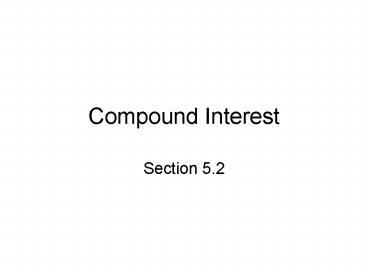Compound Interest - PowerPoint PPT Presentation
1 / 11
Title: Compound Interest
1
Compound Interest
- Section 5.2
2
Introduction
- Re-investing your interest income from an
investment makes your money grow faster over
time! This is what compound interest does. - Compound interest uses the same information as
simple interest, but what is new is the frequency
of compounding n. - n1 annual, n2 semi-annual, n4 quarterly, n12
monthly, n52 weekly, n365 daily.
3
Compound Interest Formula
- If P represents the present value, r the annual
interest rate, t the time in years, and n the
frequency of compounding, then the future value
is given by the formula - F P( 1 r/n)nt
4
Example
- Suppose you invest 32,000 into a certificate of
deposit that has an annual interest rate of 5.2
compounded annually for 3 years. - ANSWER Use the compound interest formula.
- F 32000(1.052/4)(4)(3) 32000(1.013)12
- 37,364.86
5
Annual Yield
- To compare different savings plans, you need to
have a common basis for making the comparisons. - The annual yield of a compound interest
investment is the simple interest rate that has
the same future value the compound rate would
have in one year.
6
Derivation of yield
- Future Value Compound Future value simple
- P(1 r/n)nt P(1 yt)
- Since this computation is done for 1 year, we set
t 1. - P(1 r/n)n P(1 y)
- Since P appears on both side, we divide by P and
P disappears. - (1 r/n)n 1 y, now solve for y by
subtracting 1 from both sides. - The formula for yield is y (1 r/n)n 1.
7
Example yield calculation
- Find the annual yield for an investment that has
an annual interest rate of 8.4 compounded
monthly. - ANSWER y (1 .084/12)12 1
- y (1.007)12 1 0.087310661 8.73
- The yield will usually be greater than the
interest rate. - Note the interest rate is sometimes called the
nominal interest rate.
8
Continuous Compounded Interest
- What would happen if we let the frequency of
compounding get very large. That is we would
compound not just every hour, or every minute or
every second but for every millisecond! - What happens is that the expression (1 r/n)nt
goes to ert. This e is the famous Euler number.
Its value is the irrational number 2.7182818 - The future value formula is F Pert.
- The annual yield for continuously compounded
interest is y er 1.
9
Example of Continuous Compound interest.
- Consider the 32,000 from the earlier example.
Now we will invest the money in an account that
has 5.2 annual interest compounded continuously
for 3 years. What is the future value? - ANSWER F 32000e(.052)(3) 37,402.44
- Note this investment option is only greater by
37.58. - What is the yield for this investment?
- ANSWER y e.052 1 0.05337 5.34
10
For those who know logs
- Sometimes we would like to know how long an
investment will take to grow to a certain value. - This type of question involves solving an
exponential equation. - The technique for solving these types of
equations is taking the natural logarithm of both
sides of the equation.
11
Example using the natural log
- The symbol for natural log of x is ln(x).
- Lets say we want to know how long it will take
32,000 to grow to 50,000 invested in an account
that has 5.2 annual interest compounded
quarterly. - We use the formula F P(1 r/n)nt.
- 50000 32000(1 .052/4)4t Note the unknown is
in the exponent. - Divide both sides of the equation by 32000, and
also simplify the inside of the parentheses. - This will give 1.5625 (1.013)4t .
- Now take the natural log of both sides.
- ln(1.5625) ln((1.013)4t)
- By rule, we can take the 4t and move it to the
front of the ln(1.013). - Thus the equation is now ln(1.5625)
(4t)ln(1.013). - Now divide both sides of the equation by
4ln(1.013) so that you have t isolated. - Thus t ln(1.5626)/(4ln(1.013) 8.64 years or 8
years and 8 months.































